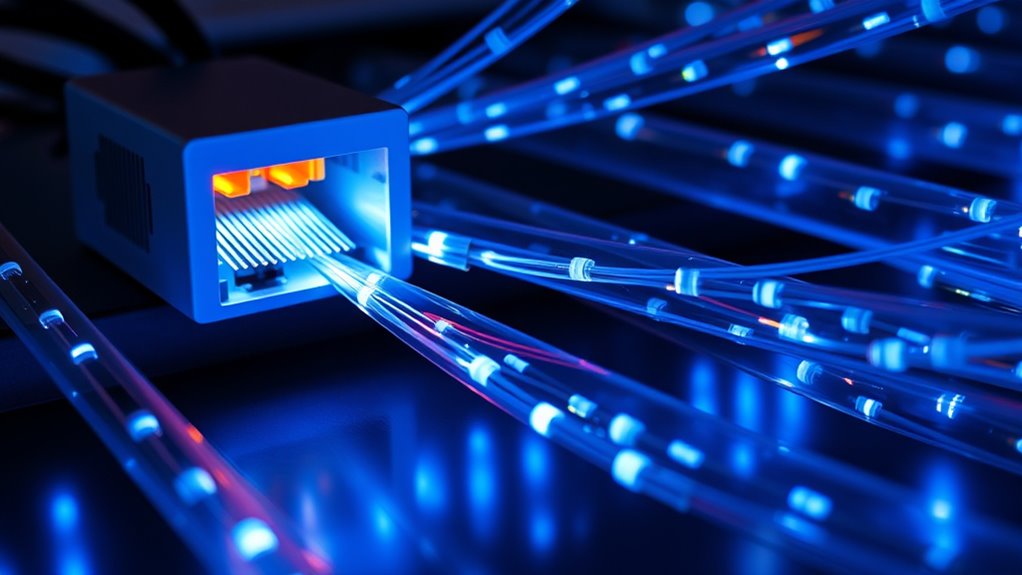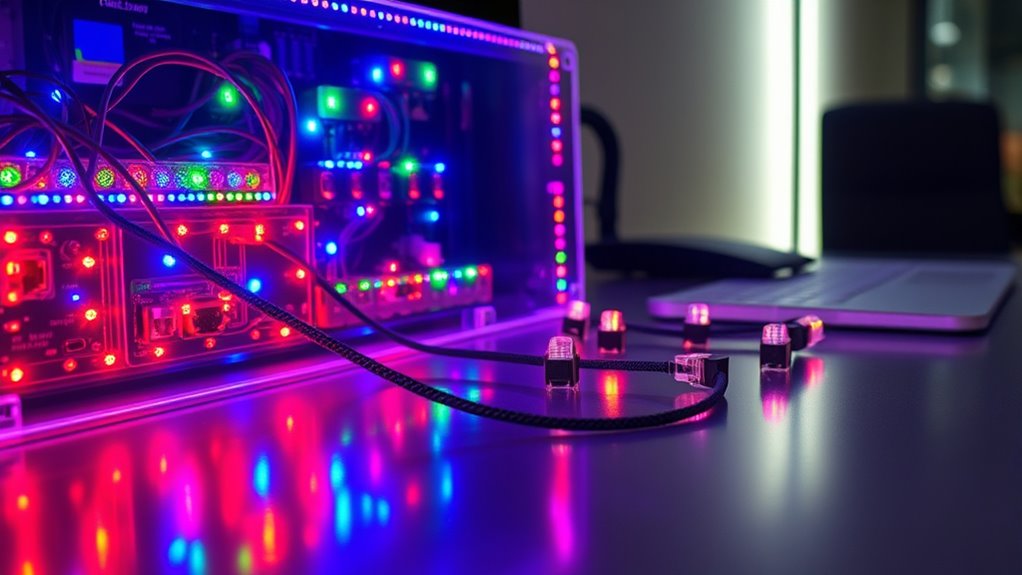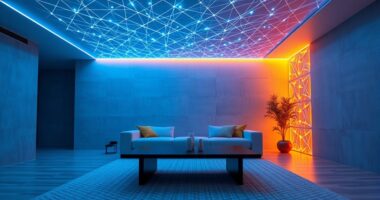PoE lighting lets you power and control LED fixtures using a single Ethernet cable, simplifying installation and reducing clutter. It combines power delivery and data transmission, enabling remote management of your lights through network-connected devices. This system promotes energy efficiency, lowers costs, and makes adjustments easy from anywhere. By integrating Ethernet with LEDs, you get a flexible, smart lighting solution that’s easy to install and manage—if you want to explore how it all works, keep going.
Key Takeaways
- PoE lighting uses Ethernet cables to supply power and data to LED fixtures, simplifying installation.
- It combines power delivery and data transmission in a single cable for efficient control.
- PoE enables remote management of LED lighting through network connections, allowing easy adjustments.
- This technology enhances energy efficiency by enabling real-time monitoring and automated scheduling.
- PoE lighting systems integrate seamlessly with smart building infrastructure for sustainable, flexible control.

Poe Lighting is redefining how you illuminate your space with innovative, energy-efficient solutions. One of the most exciting advancements in this field is Power over Ethernet (PoE) lighting systems, which allow you to power and control LED lighting fixtures through a single Ethernet cable. This technology simplifies installation, reduces clutter, and enhances your ability to manage lighting remotely. With PoE lighting, you gain the convenience of wireless control, enabling you to adjust brightness, color, or schedules from anywhere via mobile apps or centralized management systems. This flexibility gives you more precise control over your lighting environment without the need for additional wiring or complicated setups.
By using Ethernet cables to deliver both power and data, PoE lighting systems eliminate the need for separate power supplies and complex wiring infrastructure. This streamlined approach not only reduces installation costs but also ensures reliable power delivery, as Ethernet cables are designed for high data integrity and consistent current flow. The result is a more energy-efficient lighting setup that minimizes waste and optimizes performance. Since LED lights are inherently energy-efficient, combining them with PoE technology further amplifies these benefits, helping you cut down on electricity bills and lessen your environmental impact.
Wireless control is a significant advantage of PoE lighting, giving you the ability to manage your lights effortlessly. Whether you want to turn lights off when not needed, dim them during certain hours, or change colors to set a mood, you can do so remotely with a smartphone or computer. This level of control not only enhances convenience but also promotes energy savings because you can ensure lights aren’t left on unnecessarily. Additionally, scheduling functions allow you to automate lighting based on time of day or occupancy, further optimizing energy consumption.
The integration of PoE lighting into your space boosts energy efficiency by reducing waste and promoting smarter use of lighting resources. Since you can monitor and adjust lighting in real-time, you avoid over-illumination and unnecessary power use. Plus, centralized control systems mean you can implement energy-saving policies across multiple fixtures simultaneously, ensuring consistent performance and minimizing manual effort. Over time, these efficiencies translate into lower operational costs and a reduced carbon footprint.
Furthermore, understanding the importance of spoiled lemon juice and proper storage can help you maintain freshness and avoid waste in your daily life. In essence, PoE lighting combines the strengths of LED technology with modern network capabilities, offering you a seamless, energy-efficient lighting solution. It’s designed to make your space smarter, more adaptable, and more sustainable—all while providing the convenience of wireless control through Ethernet. As you embrace this innovative technology, you’ll find that managing your lighting has never been easier or more cost-effective.
Frequently Asked Questions
Can Poe Lighting Be Used With Existing Ethernet Cables?
Yes, you can use Poe lighting with your existing Ethernet cables, but you should check for Ethernet integration compatibility first. Confirm your cables support Power over Ethernet (PoE) to maintain power safety and proper operation. If your cables are rated for PoE, they can handle both data and power, making installation easier. Otherwise, you might need to upgrade to cables that support PoE standards for safe and effective lighting integration.
What Are the Safety Considerations for Poe Lighting Installations?
You might worry about electrical safety when installing PoE lighting, but proper installation precautions guarantee safety. Always verify your Ethernet cables and equipment are rated for PoE, and follow manufacturer guidelines. Use certified components and ensure proper grounding to prevent electrical hazards. By prioritizing installation precautions, you can confidently power your LEDs through Ethernet without risking damage or safety issues, making your setup both reliable and secure.
How Does Poe Lighting Compare to Traditional Power Methods?
When comparing Poe lighting to traditional power methods, you’ll find Poe offers better power efficiency by delivering electricity over Ethernet cables, reducing energy loss. It also makes installation easier since you only need a single cable for both power and data, simplifying setup and maintenance. This streamlined approach not only saves time but also minimizes clutter, making Poe lighting a practical choice for modern, efficient lighting solutions.
Are There Any Compatibility Issues With Different LED Brands?
Think of LED brands like musical instruments—some harmonize perfectly, while others might need tuning. You’ll want to check brand compatibility and make sure voltage standards align, or your setup could hit a sour note. Most Poe lighting systems are designed for broad compatibility, but always verify that your LED brand matches the voltage and connection specs. This way, your lighting symphony stays smooth, bright, and trouble-free.
What Is the Maximum Distance Poe Lighting Can Reliably Transmit Power?
You might wonder about the maximum distance Poe lighting can reliably transmit power. Generally, power limitations and cable quality play key roles here. For standard Ethernet cables, you can expect reliable power delivery up to 100 meters (328 feet). Beyond that, voltage drops can occur, reducing performance. To extend this range, consider high-quality cables or PoE extenders, ensuring consistent power and data transmission over longer distances.
Conclusion
Now that you understand how PoE lighting powers LEDs through Ethernet, imagine the possibilities ahead. As technology advances, could this seamless integration lead to smarter, more dynamic spaces? The potential for innovation is just beginning to unfold. Stay tuned—what’s next could change the way you light your world forever. The future of PoE lighting is bright, and it’s up to you to be part of the next exciting chapter.









